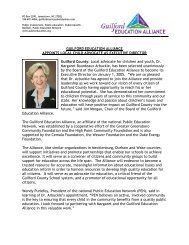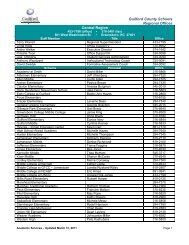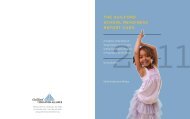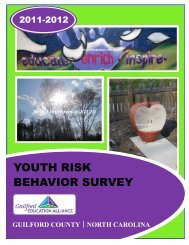2009 Advancing Excellence: A Report on Gifted Education - Guilford ...
2009 Advancing Excellence: A Report on Gifted Education - Guilford ...
2009 Advancing Excellence: A Report on Gifted Education - Guilford ...
Create successful ePaper yourself
Turn your PDF publications into a flip-book with our unique Google optimized e-Paper software.
Overview of Advanced Learners in <strong>Guilford</strong> County Schools: 65<br />
In <strong>Guilford</strong> County Schools, all programs for<br />
academically or intellectually gifted students<br />
are coordinated through the Advanced Learner<br />
department. The terms “advanced learner” or<br />
“AL” are used in place of the state label of<br />
“academically or intellectually gifted” or “AIG.”<br />
Across the country, different states and districts<br />
use various terminologies, including “gifted and<br />
talented” (GT) and “academically gifted” (AG).<br />
Missi<strong>on</strong> and Purpose<br />
The following statements are taken from<br />
the current <strong>Guilford</strong> County Schools (GCS)<br />
Advanced Learner Plan:<br />
“The missi<strong>on</strong> of the GCS Advanced Learner<br />
(AL) department is to provide rigorous,<br />
student-centered learning that affirms<br />
diversity and ensures growth for gifted<br />
students. The program is committed to the<br />
belief that gifted students require guidance<br />
in discovering, realizing and developing<br />
their talents. The department assumes<br />
the resp<strong>on</strong>sibility of maintaining rigorous<br />
curricula in <strong>Guilford</strong> County Schools. It<br />
also assumes the leadership for promoting<br />
differentiated instructi<strong>on</strong> for all students,<br />
particularly as it applies to enrichment.”<br />
A guiding principle of the advanced learner<br />
educati<strong>on</strong> program is that all children have the<br />
right to receive instructi<strong>on</strong> targeted to their<br />
current level of achievement and ability so that<br />
all children may be challenged to perform at<br />
their highest level possible.<br />
The purpose of the GCS AL program is to<br />
support gifted educati<strong>on</strong> as defined by N.C.<br />
General Statutes - Chapter 115C Article 9B (see<br />
Appendix A for a complete listing of the statute),<br />
which states that:<br />
• Public schools should challenge all students to<br />
aim for academic excellence.<br />
• Academically or intellectually gifted students<br />
perform or show the potential to perform at<br />
substantially high levels of accomplishment<br />
when compared with others of their age,<br />
experience, or envir<strong>on</strong>ment.<br />
• Academically or intellectually gifted students<br />
exhibit high performance capability in<br />
intellectual areas, specific academic fields, or<br />
in both.<br />
• Academically or intellectually gifted students<br />
require differentiated services bey<strong>on</strong>d those<br />
ordinarily provided by the regular educati<strong>on</strong><br />
program.<br />
• Outstanding abilities are present in students in<br />
all cultural groups, across all ec<strong>on</strong>omic strata,<br />
and in all areas of human endeavor.<br />
Advanced Learner Nurture Programs<br />
The AL department partners with school staffs to<br />
recognize and document gifted characteristics<br />
in children based <strong>on</strong> various research-based<br />
approaches. AL Nurture Programs are employed<br />
in GCS elementary schools to recognize and<br />
nurture the gifted characteristics of all students.<br />
Project Bright IDEA follows a unique K-2 research<br />
model to create a “vibrant community of learners<br />
and problem solvers” for kindergarten, first- and<br />
sec<strong>on</strong>d-graders. The program works to: 1) change<br />
teacher dispositi<strong>on</strong>s and capacity to choose<br />
curricula tailored to teaching gifted students<br />
from underserved populati<strong>on</strong>s; 2) study the extent<br />
to which such activities increase the number of<br />
third-graders from underrepresented populati<strong>on</strong>s<br />
who enroll in AL programs; 3) advance the<br />
quality of these students’ meta-cognitive and<br />
cognitive skills; and 4) create a research-based,<br />
multi-dimensi<strong>on</strong>al, pre-identificati<strong>on</strong> model for<br />
gifted intelligent behaviors. 66<br />
FOCUS (Fostering Outstanding Critical/Creative<br />
thinking, C<strong>on</strong>ceptual Understanding and Selfesteem)<br />
less<strong>on</strong>s offer AL instructi<strong>on</strong> in language<br />
arts and math for students from underserved<br />
populati<strong>on</strong>s in grades 3-5. The less<strong>on</strong>s use<br />
multicultural literature and emphasize skills<br />
necessary for success, including child and<br />
parent commitment, study skills, organizati<strong>on</strong><br />
and planning. 67<br />
Third Grade Whole Class Instructi<strong>on</strong> is<br />
offered during the first semester to nurture<br />
the following gifted characteristics of all<br />
students: communicati<strong>on</strong>, humor, innovati<strong>on</strong>,<br />
insightfulness, inquisitiveness, problem solving,<br />
persistence, creative thinking. Classroom<br />
teachers document observati<strong>on</strong>s of students<br />
during these less<strong>on</strong>s with AL teachers to create<br />
the talent pool for AL.<br />
65<br />
Informati<strong>on</strong> in this secti<strong>on</strong> is taken from the GCS Advanced Learner Plan (approved for 2007-2010) unless otherwise noted. The plan is available <strong>on</strong>line at<br />
http://www.gcsnc.com/boe/2007/5_24/AL_plan.pdf.<br />
66<br />
Bright IDEA is currently in use at Murphey and Allen Jay elementary schools.<br />
67<br />
FOCUS is currently offered in at least 28 elementary schools, according to a self-reporting survey submitted from AL teachers to the Advanced Learning<br />
Department. Some schools may have neglected to submit their informati<strong>on</strong>.<br />
Advanced Learner Inclusi<strong>on</strong> provides<br />
opportunities for additi<strong>on</strong>al students to<br />
participate in AL programs in schools where<br />
less than 7 percent of students are eligible for<br />
services. An alternative portfolio is developed for<br />
each of these students.<br />
Team for Advanced Learners (TAL)<br />
Each school develops a Team for Advanced<br />
Learners (TAL) to review student eligibility, to<br />
determine if further assessment is needed, or to<br />
refer for appropriate services. Additi<strong>on</strong>al TAL<br />
resp<strong>on</strong>sibilities include:<br />
• In-school m<strong>on</strong>itoring and evaluati<strong>on</strong> of the<br />
schools’ efforts for AL students;<br />
• Assisting in the development and<br />
implementati<strong>on</strong> of school-wide enrichment<br />
opportunities;<br />
• Acting as a resource for individual parents<br />
who seek further assistance from the school in<br />
meeting the needs of a particular child;<br />
• Assisting in the development and<br />
implementati<strong>on</strong> of mechanisms for helping<br />
teachers learn more about the needs of<br />
AL students and about teaching methods<br />
appropriate for serving AL students; and<br />
• Helping communicate to parents about the AL<br />
educati<strong>on</strong> program at the school.<br />
TAL membership should reflect the diversity<br />
of the student populati<strong>on</strong> of the school and<br />
should include a member representing the child’s<br />
ethnicity and gender when possible. Parents will<br />
be included when the committee is dealing with<br />
issues other than individual student eligibility. The<br />
elementary TAL includes a teacher representative<br />
from each grade level, the school principal,<br />
the teacher of the student being c<strong>on</strong>sidered for<br />
eligibility, the ESOL (English for Speakers of<br />
Other Languages) teacher and the AL curriculum<br />
specialist. The parent of a kindergarten through<br />
first semester third-grade student will be invited<br />
to sit <strong>on</strong> the TAL when his/her child’s need<br />
for differentiati<strong>on</strong> is being determined. The<br />
middle and high school TAL includes teacher<br />
representatives from core curriculum areas and<br />
each grade level, the school principal, the teacher<br />
of the student being c<strong>on</strong>sidered for eligibility, and<br />
the school counselor.<br />
AL Student Screening<br />
Following recommendati<strong>on</strong>s of researchers,<br />
GCS employs a system of multiple criteria<br />
for screening students with a need for<br />
differentiati<strong>on</strong>. The decisi<strong>on</strong>-making process<br />
includes searching, assessment (using<br />
both formal and informal measures) and<br />
implementati<strong>on</strong> of appropriate service opti<strong>on</strong>s.<br />
All third-grade students in GCS are reviewed for<br />
the AL program.<br />
Searching involves reviewing all students through<br />
informal assessments in the general educati<strong>on</strong><br />
classroom. On-going staff development and<br />
m<strong>on</strong>itoring are used to ensure that underrepresented<br />
populati<strong>on</strong>s are included in the<br />
search process.<br />
Students in K-3 who dem<strong>on</strong>strate a str<strong>on</strong>g need<br />
for differentiati<strong>on</strong> will be referred to the TAL for<br />
review. Indicators include:<br />
• Reading two or more years above grade placement.<br />
• Performing in math two or more years above<br />
grade placement.<br />
• Work sample file c<strong>on</strong>taining work samples<br />
completed at school which indicate excepti<strong>on</strong>al<br />
mastery of c<strong>on</strong>tent and skills above grade level.<br />
• Performance documented <strong>on</strong> report cards for<br />
at least two of the four most recent grading<br />
periods rated as excellent by the TAL.<br />
For students in grades 3-8, the following<br />
criteria are used to determine which students<br />
are identified as needing differentiated services<br />
(students with two or more of the required criteria<br />
will be referred to the TAL for c<strong>on</strong>siderati<strong>on</strong>):<br />
• Schools must maintain a list of all students<br />
scoring at the 85 th percentile or above <strong>on</strong> the<br />
N.C. End-of-Grade (EOG) tests and/or aptitude<br />
tests and must review these students’ needs<br />
annually for differentiated services.<br />
• Students from under-represented populati<strong>on</strong>s<br />
are referred to the TAL if classroom<br />
performance and teacher input indicates<br />
differentiati<strong>on</strong> is appropriate. (See “Nurture<br />
Programs” secti<strong>on</strong> for fostering potential of<br />
these students.)<br />
• Ongoing efforts to search for students include:<br />
• Teacher recommendati<strong>on</strong>s<br />
• Observati<strong>on</strong> checklist developed from<br />
research samples<br />
• Parents, student or community referral<br />
• Standardized test results other than EOGs<br />
• Student identificati<strong>on</strong> in another school<br />
system<br />
• Outstanding student performance as<br />
indicated in the student’s cumulative record<br />
such as grades and academic c<strong>on</strong>tests/<br />
competiti<strong>on</strong>s<br />
• Portfolio documenting outstanding student<br />
accomplishments and gifted characteristics<br />
that are not apparent through other criteria<br />
26 27












